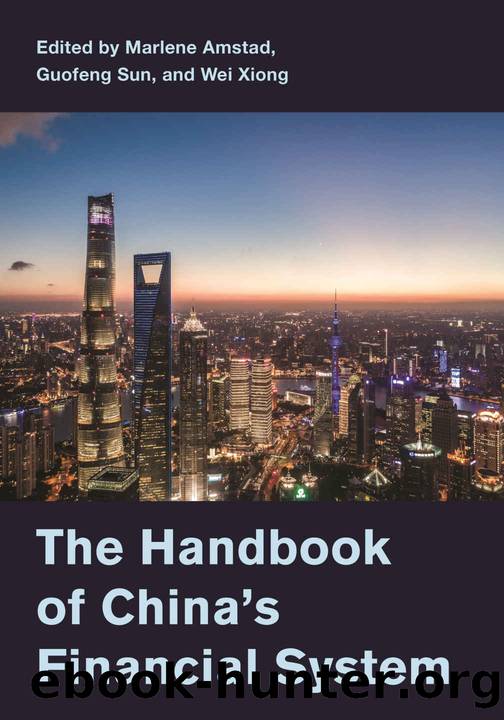The Handbook of China's Financial System by Marlene Amstad & Guofeng Sun & Wei Xiong

Author:Marlene Amstad & Guofeng Sun & Wei Xiong [Amstad, Marlene]
Language: eng
Format: azw3
ISBN: 9780691205731
Publisher: Princeton University Press
Published: 2020-11-17T00:00:00+00:00
3. INTERNATIONALIZATION OF THE RMB: CHALLENGES AND PROSPECTS
3.1. The To-Do List in RMB Internationalization
With its inclusion in the SDR currency basket, RMB has been recognized as a reserve currency. Yet, compared with major reserve currencies, the degree and quality of RMB internationalization remains limited. In fact, a truly international currency not only needs to serve as a settlement currency that is widely used in cross-border trade and investment, it also needs to be an investment currency for financial transactions, asset allocation, and store of value. The ultimate test is whether it is a âsafe-haven currencyâ that investors turn to for safety during times of turmoil rather than turning against it (Prasad, 2017). From this perspective, there is still a long to-do list for true RMB internationalization.
At present, the technical tasks include the following:
First, there should be an easy and predictable regime of institutional arrangements, so that anyone using RMB can have stable and clear expectations about the currencyâs policy environment and convenience of usage, with no need to guess or face high uncertainties.
China has opened up a variety of channels for the inflows and outflows of capital, including a qualified foreign institutional investor (QFII) scheme, a qualified domestic institutional investor (QDII) scheme, an RMB qualified foreign institutional investor (RQFII) scheme, ShanghaiâHong Kong Stock Connect and ShenzhenâHong Kong Stock Connect, and so on. Such channel arrangements are complicated and often inconvenient and offer low predictability in policy. It is necessary, therefore, to further liberalize capital accounts and establish additional facilitating institutional arrangements for capital account convertibility. To cope with sudden, large, disorderly capital flows, it is advisable to take transparent, market-based, and temporary capital flow management measures, instead of stringent and undifferentiated capital control measures through a one-size-fits-all administrative approach, which would greatly damage the confidence of investors.
Chinaâs exchange rate regime is being reformed. As it stands now, it is neither fixed nor clean floating. It is not even a managed floating regime in the traditional sense. In general, its current state will affect investorsâ expectations of the RMB exchange rate regime. Currency internationalization does not necessarily require a specific kind of exchange rate regime, be it fixed or floating. However, a floating regime seems a more natural choice for China, a large economy that needs a fairly free flow of capital and an independent monetary policy. Therefore, it could be expected to further enhance the flexibility of the RMB exchange rate to cope with larger capital flows and to play a better role of automatic stabilizer.
Going forward, the financial sector opening-up needs to proceed in tandem with the progress of exchange rate regime reform and capital account convertibility (Zhou, 2012) to allow investors to easily acquire, trade, and transfer RMB-denominated assets.
A second technical task that must be faced is the need to develop a mature capital market, increase the investor base, and enhance financial products, in particular developing a deep, broad, and liquid RMB bond market with a higher degree of openness. This is one of the most important tasks, as it is critical in transforming RMB from a settlement currency to an investment currency.
Download
This site does not store any files on its server. We only index and link to content provided by other sites. Please contact the content providers to delete copyright contents if any and email us, we'll remove relevant links or contents immediately.
International Integration of the Brazilian Economy by Elias C. Grivoyannis(90903)
The Radium Girls by Kate Moore(11921)
Turbulence by E. J. Noyes(7935)
Nudge - Improving Decisions about Health, Wealth, and Happiness by Thaler Sunstein(7615)
The Black Swan by Nassim Nicholas Taleb(7010)
Rich Dad Poor Dad by Robert T. Kiyosaki(6401)
Pioneering Portfolio Management by David F. Swensen(6226)
Man-made Catastrophes and Risk Information Concealment by Dmitry Chernov & Didier Sornette(5921)
Zero to One by Peter Thiel(5685)
Secrecy World by Jake Bernstein(4644)
Millionaire: The Philanderer, Gambler, and Duelist Who Invented Modern Finance by Janet Gleeson(4374)
The Age of Surveillance Capitalism by Shoshana Zuboff(4209)
Skin in the Game by Nassim Nicholas Taleb(4161)
Bullshit Jobs by David Graeber(4094)
The Money Culture by Michael Lewis(4076)
Skin in the Game: Hidden Asymmetries in Daily Life by Nassim Nicholas Taleb(3929)
The Dhandho Investor by Mohnish Pabrai(3699)
The Wisdom of Finance by Mihir Desai(3651)
Blockchain Basics by Daniel Drescher(3507)
